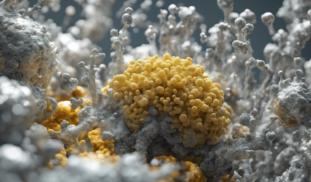129
6
0
References
- 1. Spribille, T., Tagirdzhanova, G., Goyette, S., Tuovinen, V., Case, R., & Zandberg, W. F. (2020). 3D biofilms: in search of the polysaccharides holding together lichen symbioses. FEMS Microbiology Letters, 367(5). https://doi.org/10.1093/femsle/fnaa023
- 2. Patel, P., & Free, S. J. (2022). Characterization of Neurospora crassa GH16, GH17, and GH72 gene families of cell wall crosslinking enzymes. The Cell Surface, 8, 100073. https://doi.org/10.1016/j.tcsw.2022.100073
- 3. Feng, J., Li, J., Liu, D., Xin, Y., Sun, J., Yin, W.-B., & Li, T. (2023). Generation and comprehensive analysis of Synechococcus elongatus–Aspergillus nidulans co-culture system for polyketide production. Biotechnology for Biofuels and Bioproducts, 16(1). https://doi.org/10.1186/s13068-023-02283-6
- 4. Ducat, D. C., Avelar-Rivas, J. A., Way, J. C., & Silver, P. A. (2012). Rerouting Carbon Flux To Enhance Photosynthetic Productivity. Applied and Environmental Microbiology, 78(8), 2660–2668. https://doi.org/10.1128/aem.07901-11
- 5. Wilkinson, A., Alexander, I. J., & Johnson, D. (2011). Species richness of ectomycorrhizal hyphal necromass increases soil CO2 efflux under laboratory conditions. Soil Biology and Biochemistry, 43(6), 1350–1355. https://doi.org/10.1016/j.soilbio.2011.03.009
- 6. Tanenbaum, M. E., Gilbert, L. A., Qi, L. S., Weissman, J. S., & Vale, R. D. (2014). A Protein-Tagging System for Signal Amplification in Gene Expression and Fluorescence Imaging. Cell, 159(3), 635–646. https://doi.org/10.1016/j.cell.2014.09.039
- 7. Wang, X., Schloßmacher, U., Wiens, M., Batel, R., Schröder, H. C., & Müller, W. E. G. (2012). Silicateins, silicatein interactors and cellular interplay in sponge skeletogenesis: formation of glass fiber-like spicules. FEBS Journal, 279(10), 1721–1736. https://doi.org/10.1111/j.1742-4658.2012.08533.x
- 8. Wang, H., Wang, Z., Liu, G., Cheng, X., Chi, Z., Madzak, C., Liu, C., & Chi, Z. (2020). Genetical Surface Display of Silicatein on Yarrowia lipolytica Confers Living and Renewable Biosilica–Yeast Hybrid Materials. ACS Omega, 5(13), 7555–7566. https://doi.org/10.1021/acsomega.0c00393
- 9. Cao, X., Fu, W., Yu, X., & Zhang, W. (2007). Dynamics of spicule production in the marine sponge Hymeniacidon perlevis during in vitro cell culture and seasonal development in the field. Cell and Tissue Research, 329(3), 595–608. https://doi.org/10.1007/s00441-007-0443-1
- 10. Pan, Z.-Y., Yang, Z.-M., Pan, L., Zheng, S.-P., Han, S.-Y., & Lin, Y. (2014). Displaying Candida antarctica lipase B on the cell surface of Aspergillus niger as a potential food-grade whole-cell catalyst. Journal of Industrial Microbiology and Biotechnology, 41(4), 711–720. https://doi.org/10.1007/s10295-014-1410-y
- 11. Bawazer, L. A., Izumi, M., Kolodin, D., Neilson, J. R., Schwenzer, B., & Morse, D. E. (2012). Evolutionary selection of enzymatically synthesized semiconductors from biomimetic mineralization vesicles. Proceedings of the National Academy of Sciences, 109(26). https://doi.org/10.1073/pnas.1116958109
- 12. Mikutta, R., Kleber, M., Torn, M. S. & Jahn, R. Stabilization of Soil Organic Matter: Association with Minerals or Chemical Recalcitrance? Biogeochemistry 77, 25–56 (2006).
- 13. Khakhar, A. A roadmap for the creation of synthetic lichen. Biochem Bioph Res Co (2023) doi:10.1016/j.bbrc.2023.02.079.
- 14. Cha, J. N. et al. Silicatein filaments and subunits from a marine sponge direct the polymerization of silica and silicones in vitro. Proc National Acad Sci 96, 361–365 (1999)
Like?
Please wait...
About This Project
Engineering synthetic lichens to capture CO2

